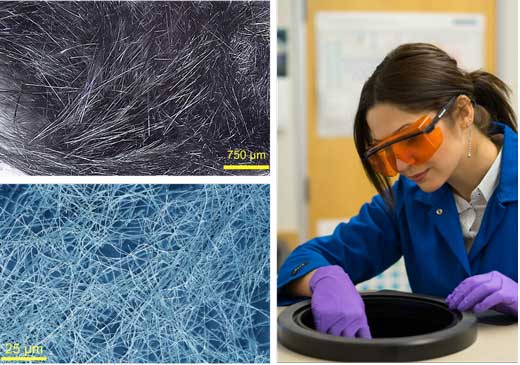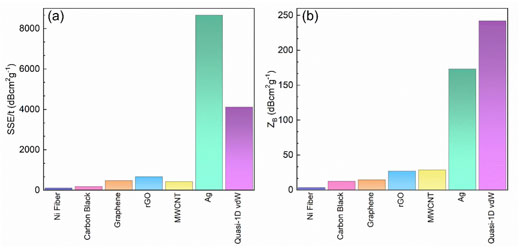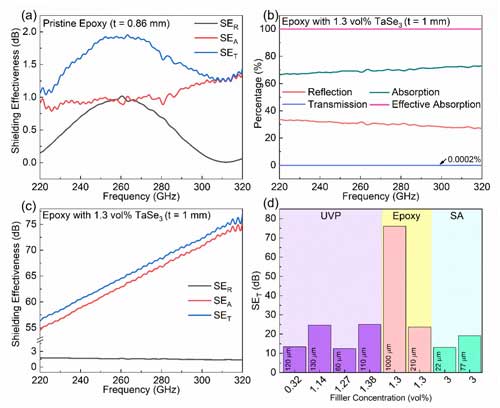| Feb 18, 2021 | |
Unique properties of 1D van der Waals materials - electromagnetic interference shielding with electrically insulating composites |
|
| (Nanowerk Spotlight) There is a strong need for more efficient electromagnetic interference (EMI) shielding materials characterized by low-weight, mechanical stability, resistance to oxidation, flexibility, and ease of manufacturing. | |
| Many applications also require EMI shielding films to be electrically insulating to avoid short circuiting of electronic components. The conventional materials for EMI shielding are metals, which are utilized as coatings and enclosures. Metals have charge carrier concentrations that enable them to block EM waves mostly by reflection. | |
| However, metallic EMI shields are heavy and prone to oxidation. An alternative approach to EMI shielding is based on the use of polymers containing electrically-conductive fillers. Conventional polymer composites for EMI shielding utilized large loading fractions of metallic particles, such that their concentrations are above the electrical percolation threshold, resulting in overall electrically conductive films. The high loading fraction of metallic fillers is required to provide sufficient EMI shielding at a given thickness of the film. | |
| In recent work, a research team led by a distinguished professor Alexander A. Balandin, Department of Electrical and Computer Engineering, University of California – Riverside (UCR), reported on the scalable synthesis of composites with unusual fillers – chemically exfoliated bundles of quasi-one-dimensional (1D) van der Waals materials (see Figure 1). | |
| Such composites demonstrated exceptional EMI shielding materials in the GHz and sub-THz frequency ranges while remaining electrically insulating. | |
| The breakthrough results have been reported in the journal Advanced Materials ("Electrically-Insulating Flexible Films with Quasi-One-Dimensional van-der-Waals Fillers as Efficient Electromagnetic Shields in GHz and Sub-THz Frequency Bands"). The first two authors of the paper, who synthesized the unique composites, are Zahra Barani, a Ph.D. student in Balandin’s research group and Dr. Fariborz Kargar, a Research Professor and Project Scientist with the Phonon Optimized Engineered Materials (POEM) Center. | |
 |
|
| Figure 1. Scanning electron microscopy of quasi-1D van der Waals materials showing as synthesized needle-like crystals (upper left panel) and the quasi-1D metal fillers after the first chemical exfoliation step (lower left panel). The photo (right panel) shows the first author of the study, PhD graduate student researcher Zahra Barani, Phonon Optimized Engineered Materials (POEM) Center, University of California, Riverside. (Images: Zahra Barani and Dr. Fariborz Kargar) | |
| The well-known two-dimensional (2D) layered van der Waals materials, such as graphene and transition metal dichalcogenides (TMDs) MX2, where M = transition metals and X = S, Se, Te, exfoliate into atomic planes. A different group of layered van der Waals materials with a quasi-1D crystal structure, such as the transition metal trichalcogenides (TMTs) exfoliates into needle-like structures rather than planes. | |
| “The key to this result was obtaining these unique fillers comprised of exfoliated bundles of atomic chains of TaSe3 – a van der Waals material with the quasi-1D crystal structure,” explains Balandin. “Their exceptional current conduction properties combined with extremely large aspect ratio allowed us to synthesized composites, which couple strongly to high-frequency RF radiation while remaining electrically insulating in DC measurements.” | |
| The obtained quasi-1D van der Waals nanowires are characterized by extremely large aspect ratios of up to ∼106. | |
| “The EM shielding effectiveness of composites is correlated with the aspect ratio of the fillers. The higher the aspect ratio, the lower the filler concentration needed to provide significant EM shielding. This is beneficial, since by lowering the filler content one would take advantage of inherent properties of polymers such as light weight and flexibility. In this regard, I can say these class of materials are exceptional once are exfoliated properly with controlling the thickness and length,” explains Kargar. | |
| The polymer composites with low loadings of such fillers (<4.5 vol %) revealed excellent EMI shielding in the X-band GHz and EHF sub-THz frequency ranges. | |
| “These novel films are promising for high-frequency communication technologies, which require EMI shielding films that are flexible, lightweight, corrosion resistant, inexpensive, and electrically insulating,” adds Balandin. | |
 |
|
| Figure 2. EMI shielding characteristics of polymeric composites with different fillers. (a) The specific EMI shielding efficiency normalized by the thickness. (b) The same plot in panel (a) normalized by the filler weight loading fraction. The ZB factor indicates the composite’s shielding effectiveness per aerial density of the filler. One can see that the composites with quasi-1D van der Waals metals outperform other materials. The lower the thickness, density, and filler weight loading fraction and the higher the total shielding effectiveness, the higher the ZB. (Image: Zahra Barani and Dr. Fariborz Kargar) | |
| “We have previously discovered that bundles of quasi-1D TaSe3 atomic threads and ZrTe3 nanoribbons can support high current densities of 10 MA/cm2 and ∼100 MA/cm2, respectively. That result motivated the present study. We were looking for an application that can benefit from nanometer scale cross-sections and extraordinary aspect ratio of the metallic conductors and their ability to sustain electrical current densities much higher than conventional metals,” explains Balandin. | |
| The synthesized composite films, while remaining electrically insulating, demonstrated exceptional performance in blocking the electromagnetic waves (see Figure 3). Even though the quasi-1D fillers do not create a percolated, electrically-conductive network, they effectively couple with electromagnetic waves. The electric field of the waves interacts with the free carriers in the quasi-1D conductors and thus enables reflection and absorption of the electromagnetic energy. | |
 |
|
| Figure 3. Electromagnetic shielding characteristics of the films with low concentration of quasi-1D TaSe3 fillers in EHF band. (a) Shielding effectiveness of pristine epoxy used as the base material for some of the composites. (b) Reflection, absorption, effective absorption, and transmission coefficients of epoxy with 1.3 vol% loading of the quasi-1D TaSe3 fillers. Note that in the EHF range, almost all the incident EM wave energy is blocked, and only 0.0002% is transmitted. (C) Reflection, absorption, and total shielding effectiveness of the same composite. Note that absorption is the dominant mechanism in blocking the EM waves in the EHF band. (d) Total shielding effectiveness of all samples tested in the EHF band. The results are shown for the frequency 320 GHz. The total shielding effectiveness scales with the loading fraction of quasi-1D fillers and the thickness of the films. (Image: Zahra Barani and Dr. Fariborz Kargar, Phonon Optimized Engineered Materials (POEM) Center, University of California, Riverside) (click on image to enlarge) | |
| Recent technological developments have demonstrated that the liquid phase exfoliation previously used for graphene and other 2D materials can also be used for quasi-1D van der Waals materials. The quasi-1D van der Waals metallic fillers can be produced inexpensively and in large quantities. | |
| “The research of the atomic bundles of quasi-1D van der Waals materials as individual conductors and composites with such materials is just at the beginning. I am sure we will soon see a lot of progress with quasi-1D van der Waals materials as it happened with quasi-2D materials,” concludes Balandin. | |
| Provided by University of California – Riverside as a Nanowerk exclusive | |
|
Become a Spotlight guest author! Join our large and growing group of guest contributors. Have you just published a scientific paper or have other exciting developments to share with the nanotechnology community? Here is how to publish on nanowerk.com. |
|
